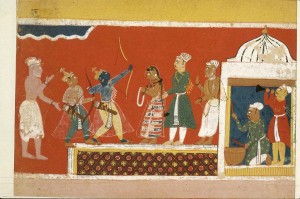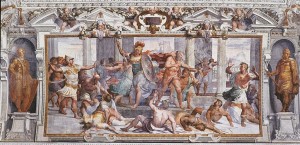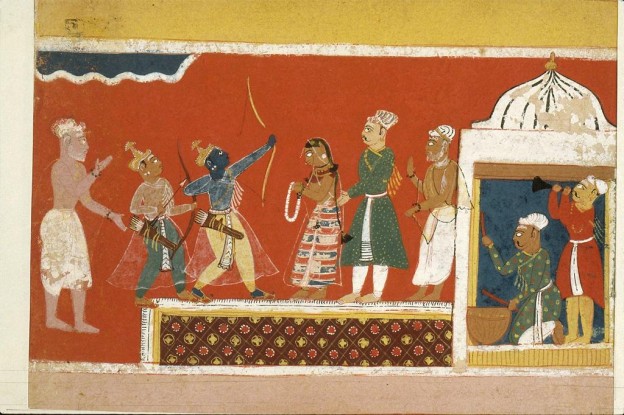Epics serve as a cultural foundation for those cultures that have embraced this tradition. Their continued modernized retellings and archetypal characters promote a homogenized culture. In the Hindu epic The Ramayana, Rama himself is often understood to be the archetypal king and Sita the archetypal wife, granting readers models by which to base their actions. Greek tradition has Odysseus and Penelope filling those roles with the epic The Odyssey.
The relationships of these two archetypal couples share many similarities among their obvious differences. The scene in each epic where the man has to string a bow to win his woman is begging for comparison with so many artistic renditions of this particular scene from both cultures, as well as the obvious plot similarities.
From a perspective that includes the theologies of the cultures involved, both men are participating in a test to win their wives back. Also, this test is urged by gods who know the outcome beforehand, causing many mortals to participate in this competition with no chance of success.
Though comparable, these scenes inform us of striking differences between the two couples, as well as between the two cultures. We see from the Hindu epic that Sita peacefully sits by and awaits her fate that has been assigned to her by the men in her life. The Greek Penelope, contrary to the woman in waiting that Sita represents, actively fights the decisions of the men that flock to her location and attempt to subvert her will. Penelope, as the archetypal Greek woman/wife, demonstrates much more personal power and agency than Sita does in The Ramayana, pointing to the different roles for women in the different societies.
From the way that Sita sits and waits to accept her husband, we see that women are expected to be subservient to the men in their lives in Hindu culture. Even beyond the apparently unimportant decision of who she is to spend the rest of her life with, Sita takes no actions to preserve her life or to better her situation. We even get multiple references of Sita refusing to save herself, as if it is her husband’s job to do so. (Buck)
The cultural impact of having such a subservient model for Hindu women would, from the perspective of one who grew up with Greek epics, seem to lead to a culture of subservience among women. Paula Richman points out in the introduction to her book The Diversity of the Ramayana Tradition there are many tellings of The Ramayana for all sorts of political/social/religious purposes. Some of these versions of this epic paint Sita in a very different light, and, as Richman discusses, the Valmiki version of the text that we get is the male version of the story, told by men to men for men, and that this text likely wouldn’t have as much of an impact on women of the culture as the women’s tales would. (Richman)
Homer’s telling of Odysseus’s tale has generally been accepted as the authoritative version of the text and has, consequently, a much greater impact on the social norms of the inheritors of Greek culture than Valmiki’s tale of Rama on its cultural inheritors. It seems as if this single authoritative text has granted a larger amount of cultural cohesion, and therefore a clearer cultural identity, than the multiple tellings of Rama’s tale. From an outsider’s perspective, it would be easier to get a sense of Greek culture from reading The Odyssey than it would be to get an idea of Hindu culture by reading The Ramayana.
This quintessential scene of bow-stringing could be used as a prime example: we see how women from different cultures are portrayed in comparable situation, and thus can gain a better understanding of the motivations of women from those cultures. Taking just this one scene informs readers that women of Greek culture were expected to be more active than women of Hindu culture in the preservation of themselves. Such comparison, at the very least, suggests more power rested in the hands of Greek women than of Hindu women, and offers academics a basis for such a belief. From there, it might be possible to discover why women were expected to take a more active role in Greek culture than in Hindu culture, or what other cultural norms are tied into this expectation of action.
-

A manuscript illustration of immediately after Rama strings the bow to win Sita. “Rama Breaks The Bow,” from a Ramayana manuscript (Bala Kanda).
http://library.artstor.org.ezproxy.uvm.edu/library/secure/ViewImages?id=8DNQZjU4ODA5Jy80fTJrKngqVXQtd1N4cw%3D%3D&userId=hDJDdDcl&zoomparams=
The affect of these epics has not been diminished over time, even though societies change, languages change, and story-telling mediums change. That artists in 1640 CE dedicated their time and resources to create this manuscript illustration of Rama stringing the bow to win Sita is a clear indicator of the importance Hindu culture places on this scene. It also is a prime example of the repeated creation/retelling of this epic throughout the ages. The mural in Genoa is equally such an example for The Odyssey.
As technology, availability of resources, populations, and languages change, so too must the medium of the epics change if they are to remain an active part of society. Amar Chitra Katha published a comic-book telling of The Ramayana in the mid 20th century, allowing traditional Hindu folklore to be consumed by various audiences in an inexpensive portable form, from young children who could look at the pictures and follow along to learned scholars who now have access to a large collection of stories from Hindu culture. It is important to remember that this is one version of the epic among many and that it builds on earlier traditions, like the inclusion of illustrations in manuscripts.
This step in modernizing the epic of Rama is only one of the ways The Ramayana has managed to continue influencing a Hindu understanding of what it means to be Hindu. This proliferation has been realized in the production of comic books, translations into many languages, television series, movies, and even web series. In 1987 Doordarshan, a Hindu government broadcast network, released a television series of The Ramayana that was so popular it caused nationwide labor strikes when it was scheduled to end. This televised, government sponsored version of The Ramayana was so influential thousands of years after the story was first told that entire villages pooled their resources to be able to view it.(Richman) Clearly, there is still a power to move the populations built into the epic.
In 1997, a miniseries depiction of The Odyssey that would go on to win Emmy awards was first aired on US television. This 176 minute televised program portrayed in a modernized medium the ancient Greek epic. I, for one, remember many Saturday afternoons wiled away watching this miniseries and many others like it. This early exposure to the epics of my culture in such a readily digestible format as a television program has given me a foundation upon which to judge the culture around me. Even now, out of all of the many hours of film and television I’ve seen of my cultural inheritance, the scene that stands out the most in my mind is the dramatic revealing of Odysseus before he slays the suitors.

A salon mural of immediately after Odysseus strings the bow to win Penelope. “Odysseus Slays the Suitors in His Palace at Ithaca.” http://library.artstor.org.ezproxy.uvm.edu/library/secure/ViewImages?id=8CJGczI9NzldLS1WEDhzTnkrX3ogdVp7eiI%3D&userId=hDJDdDcl&zoomparams=
These epics have had a marked influence on the populations that endorse them, even into the modern era. By comparing similar scenes from two different cultures’ epics, we can gain a clearer insight into the forces that move people, notably where different cultures share values, and why there might be disagreement between others. Further analysis of epic literature from across multiple cultures could lead to people realizing that they share more culturally than they might have previously believed, and understanding the origins of their differences could ultimately lead to reconciliation thereof.
Legal stuff
Disclaimer: I do not endorse the authenticity of any of the websites linked to this page and deny any responsibility for the information therein presented.
Works Cited:
Genoa: Villa Pallavicino Delle Peschiere: Salon: Odysseus Slays the Suitors in His Palace at Ithaca.
http://library.artstor.org.ezproxy.uvm.edu/library/secure/ViewImages?id=8CJGczI9NzldLS1WEDhzTnkrX3ogdVp7eiI%3D&userId=hDJDdDcl&zoomparams=
Homer. The Odyssey. Trans. Robert Fitzgerald. New York: Farrar Straus Girous, 1961. Print.
Katha, Amar Chitra. Rama. Amar Chitra Katha, 2009. Media
Rama Breaks The Bow, from a Ramayana manuscript (Bala Kanda).
http://library.artstor.org.ezproxy.uvm.edu/library/secure/ViewImages?id=8DNQZjU4ODA5Jy80fTJrKngqVXQtd1N4cw%3D%3D&userId=hDJDdDcl&zoomparams=
Richman, Paula. “Introduction: The Diversity of the Ramayana Tradition,” in Many, ed. Paula Richman (Berkeley: University of California Press, 1991), 3-21. On BBR?m?ya?as
The Odyssey. Dir. Andrei Konchalovsky. Perf. Armand Assante, Greta Scacchi, Isabella Rossellini. NBC, 1997. Miniseries. (for more information: http://www.imdb.com/title/tt0118414/)
Valmiki. Ramayana. Trans. William Buck. University of California Press, 2012. Print
